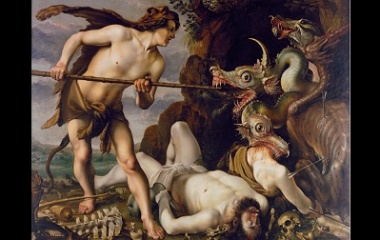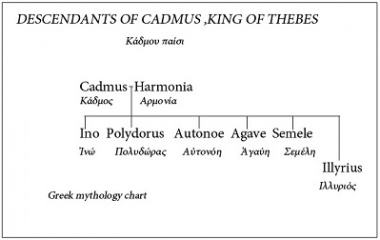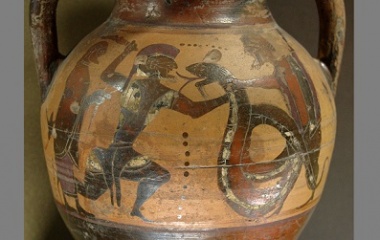- Pronunciation: CAD-muss
- Origin: Greek
- Role: Hero
- Symbols: Alphabet
- Wife: Harmonia
- Children: Autonoe, Ino, Semele, Agave and Polydorus
- Siblings: Phoenix, Cilix, Europa
Who Is Cadmus?
In Greek mythology, Cadmus is known as the founder and first king of Thebes. He led a long and adventurous life and is considered to be just as heroic as the legendary combination of Pegasus and Bellerophon. Cadmus is best known for introducing the Greeks to the Phoenician alphabet. They then adapted it, made it their own and introduced it to the rest of the world.
Origins
Cadmus’ parents were King Agenor and Queen Telephassa, who ruled the Phoenician city of Tyre. As a young prince, Cadmus lived an extravagant and adventurous life surrounded by family. His siblings were Phoenix, Cilix and Europa. Europa would play an important role in his future. He eventually become known as the first Greek hero as he followed the life path the gods laid out for him.
Legends and Stories
Cadmus is known as the first Greek hero, and there are two main legends that are associated with his journey.
Lost Sister
As previously mentioned, Cadmus’ sister Europa would play a large part in his life. One day, Europa was out with her friends gathering flowers, when Zeus approached them disguised as a white bull. Europa moved toward the bull in order to stroke him, but when she stepped on him, the bull ran off, kidnapping Europa on his back. He swam through the sea and arrived in Crete. It was then that Europa realized she had been kidnapped by Zeus. She married a local king, making her the first queen of Crete.
However, her family did not know what had become of her and her father sent all of her brothers out to find her. He told them not to return until they had rescued their sister. Their mother also accompanied them while they searched all over for their beloved Europa. But there were no clues to her whereabouts and the brothers began to settle in different areas, unable to return home to their father.
A Cow and a Town
Cadmus and his mother settled together in Thrace. His mother died soon after, as the grief of her missing daughter was too much for her heart to take. Cadmus properly honored his mother and then set off to the oracle of Delphi to begin the search for his sister once again.
He was surprised when the oracle told him to stop searching for his sister. Instead, he was to found a new city. He was instructed to find a cow with the symbol of a half-moon on it, and follow it until it stopped to rest. In this spot, he was to build a new city.
Cadmus wanted to sacrifice the cow to Athena in order to thank her for allowing him to make progress on his journey. In order to complete the sacrifice, he sent his friends to look for pure water. They found a spring and began to fil their vessels, when a fierce dragon attacked them, killing every last one.
When no one returned, Cadmus set out to look for his friends. He too came across the dragon and then slayed it in revenge. He then finally sacrificed the cow to Athena, who told him to retrieve the teeth of the dragon and plant them. From the soil emerged a tribe of fierce warriors. They immediately began fighting each other and continued the battle until only five remained. They finally made peace, and became known as the Spartoi. They then helped Cadmus build the city of Cadmea, which he would eventually rename Thebes, after the Egyptian city of the same name.
Family
Unbeknownst to Cadmus, the slayed dragon was the son of the god Ares. Ares was furious with Cadmus and punished him by making him his servant for the next eight years. After his time was served, Ares forgave Cadmus. In fact, he even gave him his daughter, Harmonia, in marriage. All of the gods came to the wedding, and the god Hephaestus gave Cadmus a golden necklace to present to his new bride.
The couple had five children together, named Autonoe, Ino, Semele, Agave and Polydorus. Cadmus thought he had moved on after the unforeseen slaying of the dragon, but a curse still loomed over his family. With the support of his wife and family, Cadmus moved his loved ones to the land of the Enchelians. The people there appointed him king, and he soon led them to victory against a neighboring tribe they were battling.
When the war was over, Harmonia gave birth to another son, Illyria. After the birth, Cadmus began to struggle with his inner thoughts. He felt that a serpent would be happier than he was. Ares got his final revenge on Cadmus by transforming him into the serpent that he had fantasized about being. Harmonia was devastated, and asked the gods to give her the same fate. Zeus felt pity for the lovers and eventually brought them to the Elysian Fields, a plot of land reserved for those favored by the gods, where they entered the afterlife.
Appearance
Cadmus is typically depicted as a simple man. He is sometimes in plain clothing, and at other times in outfits that only a king would wear. Because he was a hero and a successful warrior, he is also shown in his armor. Overall, he was an attractive young man whose presence was powerful and commanding. If you see a work of art depicting Cadmus, he will most likely be fighting a dragon, sowing the dragon’s teeth, or will be shown as a serpent with his wife Harmonia.
Symbology
There are three main elements most commonly associated with Cadmus. The first is the alphabet, which he introduced to the Greeks, and essentially the rest of the world as it spread to the Romans and the rest of Europe. He is also associated with the cow that he followed until it rested, leading to the founding of a new city. The final thing most commonly associated with Cadmus is the act of sowing, which led to the Spartoi.











When was this published?